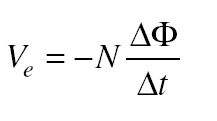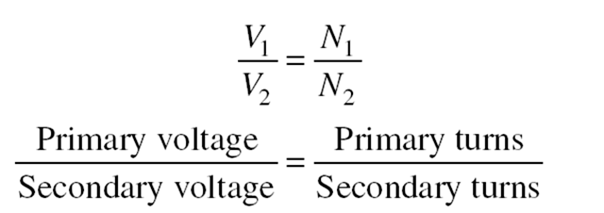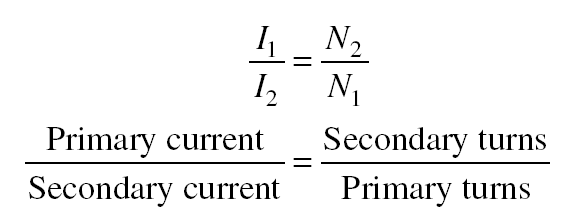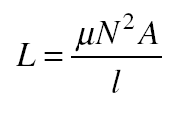Electro- magnetic Induction
In This Chapter:
✔ Electromagnetic Induction
✔ Faraday’s Law
✔ Lenz’s Law
✔ The Transformer
✔ Self-Inductance
✔ Inductors in Combination
✔ Energy of a Current-Carrying Inductor
Electromagnetic Induction
A current is produced in a conductor whenever the cur- rent cuts across magnetic field lines, a phenomenon known as electromagnetic induction. If the motion is parallel to the field lines of force, there is no effect. Electromagnetic induction originates in the force a magnetic field exerts on a moving charge. When a wire moves across a magnetic field, the electrons it contains
experience sideways forces that push them along the wire to cause a cur- rent. It is not even necessary for there to be relative motion of a wire and a source of magnetic field, since a magnetic field whose strength is changing has moving field lines associated with it and a current will be induced in a conductor that is in the path of these moving field lines.
When a straight conductor of length l is moving across a magnetic field B with the velocity v, the emf induced in the conductor is given by
Induced emf = Ve = Blv
when B, v, and the conductor are all perpendicular to one another.
Solved Problem 16.1 The vertical component of the earth’s magnetic field in a certain region is 3 × 10−5 T. What is the potential difference be- tween the rear wheels of a car, which are 1.5 m apart, when the car’s ve- locity is 20 m/s?
Solution. The real axle of the car may be considered as a rod of 1.5 m long-moving perpendicular to the magnetic field’s vertical component. The potential difference between the wheels is therefore
Faraday’s Law
Figure 16-1 shows a coil (called a solenoid ) of N turns that encloses an area A. The axis of the coil is parallel to a magnetic field B. According to Faraday’s law of electromagnetic induction, the emf induced in the coil when the product BA changes by D(BA) in the time Dt is given by The quantity BA is called the magnetic flux enclosed by the coil and is de- noted by the symbol F (Greek capital letter phi):
The quantity BA is called the magnetic flux enclosed by the coil and is de- noted by the symbol F (Greek capital letter phi):
Figure 16-1
The unit of magnetic flux is the weber (Wb), where 1 Wb = 1 T·m2. Thus, Faraday’s law can be written
Lenz’s Law
The minus sign in Faraday’s law is a consequence of Lenz’s law:
An induced current is always in such a direction that its own magnetic field acts to oppose the effect that created it.
For example, if B is decreasing in magnitude in the situation of Fig- ure 16-1, the induced current in the coil will be counterclockwise in or- der that its own magnetic field will add to B and so reduce the rate at which B is decreasing. Similarly, if B is increasing, the induced current in the coil will be clockwise so that its own magnetic field will subtract from B and thus reduce the rate at which B is increasing.
The Transformer
A transformer consists of two coils of wire, usually wound on an iron core. When an alternating current is passed through one of the windings, the changing magnetic field it gives rise to induces an alternating current in the other winding. The potential difference per turn is the same in both
primary and secondary windings, so the ratio of turns in the winding determines the ratio of voltages across them:
Secondary turns
Since the power I1V1 going into a transformer must equal the power I2V2 going out, where I1 and I2 are the primary and secondary currents, respectively, the ratio of currents is inversely proportional to the ratio of turns:
Self-Inductance
When the current in a circuit changes, the magnetic field enclosed by the circuit also changes, and the resulting change in flux leads to a self-induced emf of Here D I/Dt is the rate of change of the current, and L is a property of the circuit called its self-inductance, or, more commonly, its inductance. The minus sign indicates that the direction of Ve is such as to oppose the change in current DI that caused it.
Here D I/Dt is the rate of change of the current, and L is a property of the circuit called its self-inductance, or, more commonly, its inductance. The minus sign indicates that the direction of Ve is such as to oppose the change in current DI that caused it.
The unit of inductance is the henry (H). A circuit or circuit element that has an inductance of 1 H will have a self-induced emf of 1 V when the current through it changes at the rate of 1 A/s. Because the henry is a rather large unit, the millihenry and microhenry are often used, where
1 millihenry = 1 mH = 10−3 H
1 microhenry = 1 mH = 10−6 H
A circuit element with inductance is called an inductor. A solenoid is an example of an inductor. The inductance of a solenoid is where m is the permeability of the core material, N is the number of turns,
where m is the permeability of the core material, N is the number of turns,
A is the cross-sectional area, and l is the length of the solenoid.
Inductors in Combination
When two or more inductors are sufficiently far apart for them not to in- teract electromagnetically, their equivalent inductances when they are connected in series and in parallel are as follows:
Connecting coils in parallel reduces the total inductance to less than that of any of the individual coils. This is rarely done because coils are relatively large and expensive compared with other electronic components; a coil of the required smaller inductance would normally be used in the first place.
Because the magnetic field of a current-carrying coil extends beyond the inductor itself, the total inductance of two or more connected coils will be changed if they are close to one another. Depending
on how the coils are arranged, the total inductance may be larger or smaller than if the coils were farther apart. This effect is called mutual inductance and is not considered in the above formula.
Solved Problem 16.2 Find the equivalent inductances of a 5- and an 8mH inductor when they are connected in (a) series and (b) parallel.
 Energy of a Current-Carrying Inductor
Energy of a Current-Carrying Inductor
Because a self-induced emf opposes any change in an inductor, work has to be done against this emf to establish a current in the inductor. This work is stored as magnetic potential energy. If L is the inductance of an inductor, its potential energy when it carries the current I is
This energy powers the self-induced emf that opposes any decrease in the current through the inductor.

![Electro- magnetic Induction ]_Page_112_Image_0001 Electro- magnetic Induction ]_Page_112_Image_0001](http://lh5.ggpht.com/-YeRGG5IjFW8/VE6AYzPbpeI/AAAAAAAArx8/5d53plaFucA/Electro-%252520magnetic%252520Induction%252520%25255D_Page_112_Image_0001_thumb.jpg?imgmax=800)
